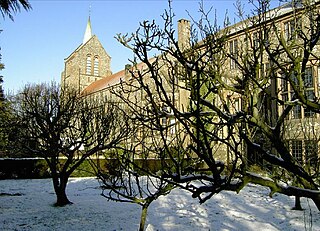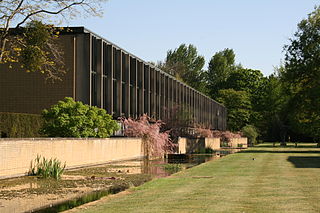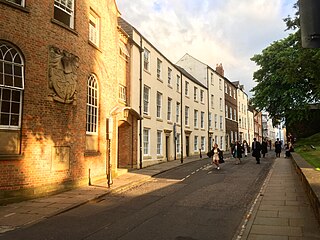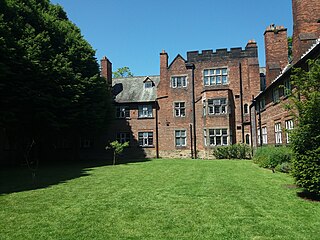
Greyfriars is a Roman Catholic friary and parish located in East Oxford, which until 2008 was also a permanent private hall of the University of Oxford. Situated on the Iffley Road in East Oxford, it was one of the smallest constituent halls of the university. Its status as a permanent private hall (PPH) derived from the fact that it was governed by an outside institution, rather than by the fellows of the University as a constituent college is.

St Catherine's College is one of the constituent colleges of the University of Oxford. In 1974, it was also one of the first men's colleges to admit women. It has 528 undergraduate students, 385 graduate students and 37 visiting students as of December 2020, making it one of the largest colleges in either Oxford or Cambridge.

University College, informally known as Castle, is the oldest constituent college of Durham University in England. Centred on Durham Castle on Palace Green, it was founded in 1832 by William van Mildert, Bishop of Durham. As a constituent college of Durham University, it is listed as a higher education institution under section 216 of the Education Reform Act 1988. Almost all academic activities, such as research and tutoring, occur at a university level.

Trevelyan College is a college of Durham University, England. Founded in 1966, the college takes its name from social historian George Macaulay Trevelyan, Chancellor of the university from 1950 to 1957. Originally an all-female college, the college became fully mixed in 1992.

This is a list of halls of residence on the various campuses of the University of Nottingham in Nottingham, England.

St Chad's College is one of the recognised colleges of Durham University. Founded in 1904 as St Chad's Hall for the training of Church of England clergy, the college ceased theological training in 1971 and now accommodates students studying the full range of Durham University courses. Its members are termed "Chadsians" and it is the smallest Durham college by number of undergraduates, but has extensive college library facilities and among the highest level of academic performance.

Hatfield College is one of the constituent colleges of Durham University in England. It occupies a city centre site above the River Wear on the World Heritage Site peninsula, lying adjacent to North Bailey and only a short distance from Durham Cathedral. Taking its name from a medieval Prince-Bishop of Durham, the college was founded in 1846 as Bishop Hatfield's Hall by David Melville, a former Oxford don.

St Mary’s College is a constituent college of Durham University. It is located mainly on Elvet Hill to the South of the city centre, becoming the first of Durham’s “hill colleges”. Following the grant of a supplemental charter in 1895 allowing women to receive degrees of the university, St Mary's was founded as a women’s only college called the Women’s Hostel in 1899, adopting its present name in May 1920. It enjoys a reputation as one of the most attractive colleges of Durham because of its neoclassical architecture and picturesque landscape.

Van Mildert College is one of the 17 constituent colleges of Durham University. The college was founded in 1965 and takes its name from William Van Mildert, the last Prince-Bishop to rule the County Palatine of Durham and a leading figure in the university's foundation. Originally an all-male college, Van Mildert admitted female undergraduates for the first time in 1972, making it the first Durham college to become mixed.

Queen's College is a residential college affiliated with the University of Melbourne. It is a residential community of 300 students who attend the University of Melbourne, RMIT University, Victorian College of the Arts and Monash University Faculty of Pharmacy and Pharmaceutical Sciences. These students come from across regional Victoria, interstate and overseas. Queen's College also houses a number of resident tutors, staff and academic guests.

Wills Hall is one of more than twenty halls of residence in the University of Bristol. It is located high on the Stoke Bishop site on the edge of the Bristol Downs, and houses c. 370 students in two quadrangles. Almost all of these students are in their first year of study.

St. John’s College is an Anglican college affiliated to the University of Hong Kong, which provides accommodation to undergraduates and postgraduates. As the successor of St. John’s Hall, which was founded in 1912, the College is the oldest residential hall/college of the University. Constitutionally, the College is a body corporate established by statute, the St. John’s College Ordinance, on 27 April 1956. As such, unlike other residential halls/colleges that are directly administered by the University, the College enjoys financial and administrative independence. The Ricci Hall, run by the Jesuits, is the only other non-University-administered hall.

Wessex Lane Halls is a halls of residence complex owned by the University of Southampton. It is situated in the Swaythling district of Southampton, approximately one mile north-east of the university campus in Highfield.

A common room is a group into which students are organised in some universities, particularly in the United Kingdom, normally in a subdivision of the university such as a college or hall of residence, in addition to an institution-wide students' union. They represent their members within the hall or college, operate certain services within these institutions such as laundry or recreation, and provide opportunities for socialising. There are variations based on institutional tradition and needs, but classically the following common rooms will exist:

Formal hall or formal meal is a meal held at some of the oldest universities in the United Kingdom and the Republic of Ireland at which students usually dress in formal attire and often gowns to dine. These are held commonly in the colleges of Oxford, Cambridge and Durham, at Trinity College Dublin, and in some halls and colleges at St Andrews, and the Australian sandstone universities, and at Trinity College, Toronto.

Hulme Hall is a traditional University of Manchester hall of residence situated at the Victoria Park Campus in Rusholme, Manchester, housing 300 students. It has a range of facilities including the John Hartshorne Centre: a 300 seat lecture theatre with attached seminar rooms; a library; Junior Common Room and study spaces; music room; old dining hall; the Victoria Park bar; and chapel.
Akuafo Hall otherwise referred to as the Hall of Excellence is the second Hall of residence to be established in the University College of the Gold Coast now University of Ghana. The Hall has its own statutes governing the administration of its affairs while the affairs of students are organized and supervised by Executives of the Junior Common Room.
Jeremy Nigel Morris is a British historian, Church of England priest and academic. He specialises in church history. From 2014 to 2021, he was Master of Trinity Hall, Cambridge. Previously, he was Dean of Trinity Hall from 2001 to 2010, and Dean of the Chapel of King's College, Cambridge from 2010 to 2014.

St Aidan’s College was a Church of England theological college in Birkenhead, Cheshire, England, open from 1847 to 1970.

Cranmer Hall is a Church of England theological college based at Durham, England. Cranmer Hall forms part of St John's College, Durham which is a recognised college of Durham University. It stands in the Open Evangelical tradition.




























